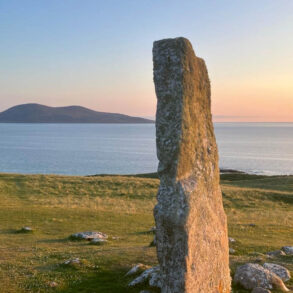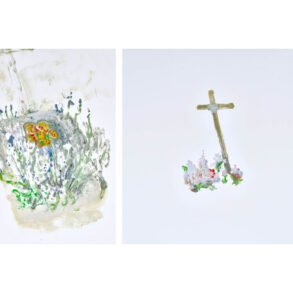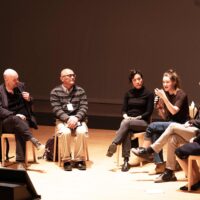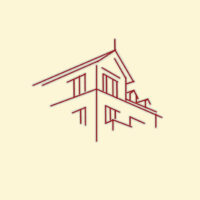This fall, a new one-year art course taught in German will begin at the Goetheanum. What impulse has driven the two initiators to offer the course? Interview by Wolfgang Held.
How did the idea for an artistic study year at the Goetheanum come about?
Barbara Schnetzler It was mainly the students here at the Goetheanum who provided the impetus. They kept asking to be able to work more artistically. I experience this again and again in my courses, that there is a longing to artistically process what they have heard and read. And on the other hand, it was Christian Hitsch and Thorwald Thiersch who, as experienced artists, approached me and said: “This is what we need!” Then, Christiane and I thought: “Let’s do it, let’s just try it!”
The idea of a year of study also arose from the attitude towards life today. After finishing school, younger people are often on the lookout for what’s next, so a year studying art can provide them with a foundation. In addition, such a year of study helps them to find a new place for themselves through anthroposophy and through knowledge of the quality of life—what we mean when we say something is “living”—but also to get to know themselves differently, to center themselves and bring themselves together, and then to take the next step.
The course comprises three trimesters: one in architecture, one in painting, and one in sculpture. So, is it more than an introductory course but less than a full course of study in a profession?
Schnetzler Yes, it’s comparable to a preliminary course at an art school, where you immerse yourself in many areas. What we can offer here in an academic year is a chance to deepen and acquire certain artistic skills in terms of craftsmanship, sculpture, or color.
What are some of the specific techniques studied?
Schnetzler For example, students will learn how to stretch surfaces in a beautiful way. When a form has an inner life, then I know where I have to spread the clay in order to create the impression that something living is unfolding. First, we work on the basic shapes, and then we also work on sculpting, i.e., the technical handling of the stone. How do I cut and grind a stone? How do I set an edge? These form experiences then lead us to the theory of metamorphosis.
Christiane Haid A friend of mine had taken part in Christian Hitsch’s previous study year. After a career change, he was uncertain and without direction. The year of study gave him a new biographical impulse, and he then taught as an arts and crafts teacher for twenty years. Such a one-year period of education is often a biographical turning point. At anthroposophically inspired art schools, such as the University of Applied Sciences and Arts in Ottersberg or Alanus University, the professional qualification plays a central role rather than the foundations of the anthroposophical art impulse. This is different for us: here, on site, we have original artworks: from the archive, to the “Representative of Humanity” and the Goetheanum itself—these are the works of art that we focus on. This offers the best opportunities to really delve into the reality of the originals and to study the impulses given by Rudolf Steiner’s artistic impulse and Goetheanism. Making this possible is, for me, the central task of the Visual Art Section.
I see it as having two directions. On the one side, what can be described as the classical anthroposophical artistic impulse that developed in the language of forms of the First Goetheanum up through the Second Goetheanum. On the other, it’s about being inspired by the study of anthroposophy and designing anew out of that inspiration. One focus of our offering is to get to know the foundations of Rudolf Steiner’s artistic impulse. Of course, there’s then free time, where the participants can develop what they’ve learned into their own expression. We want to facilitate and encourage this as much as possible in the short time available. We are looking for people who are existentially interested in working artistically.
Nevertheless, it’s not a full art education, right?
Haid We spend eleven weeks each on painting, sculpture, and architecture. This aims at the core of each area. At the same time, we experience anthroposophy through artistic activity. Every morning, we also study Rudolf Steiner’s basic works. Renatus Ziegler and I take care of that. However, practical artistic work is also the focus of our time. By working with clay, wood, and paint, each of the students can unfold their self-efficacy. Connecting with this capacity within us seems essential to me in a digitalized culture, because many people currently have the problem of not being able to experience self-efficacy. In this sense, the group as a learning community is also a central concern for us. In a community, something can emerge in encounters between students that no book or private study can replace. We want to provide a space for this.
The existing study programs around the Goetheanum contribute to making this a place full of lively forces. Will your training here become the next energy cell?
Haid I hope so! I am delighted that with Barbara Schnetzler and Nathaniel Williams we have younger lecturers and, with Esther Gerster and Christian Hitsch, we have people on the team who have been teaching for decades and have something to pass on that is no longer abundantly available.
What response have you had to your initiative?
Schnetzler We’ve only been underway with our idea since Christmas, so I can’t say much about it. There were some people who were pleased that the studios on the Goetheanum campus are now being revitalized.
Haid It’s not easy, because study courses and conference operations have to go hand in hand. This always becomes apparent when we need to look for work rooms on the premises. We’re pleased that we can carry out our text studies one floor above the other students here. This allows us to meet up with them right from the start. We are located in the northern part of the carpentry workshop. For the future, I would like to see more training opportunities on-site on all kinds of life issues. That will rejuvenate this place! At the same time, we have to see what is feasible. Now, we are sending out a call and hope that we’ll receive a lot of interest in response.
Is it possible to attend just one trimester and limit yourself to one artistic field?
Haid Yes. It’s possible to study sculpture with Barbara Schnetzler for only one trimester of eleven weeks at a time, or only architecture with Christian Hitsch and Pieter van der Ree, or only painting with Esther Gerster and Nathaniel Williams in the summer. The choice is yours.
Schnetzler We may well adjust the individual trimesters depending on interest.
What core idea is guiding you?
Haid For me, it’s essential during the study year not to grasp anthroposophy as a pure study but rather to internalize it through art. This is a different approach because it involves the head, heart, and hands directly. Last summer, we had an intensive art week about the First Goetheanum: 24 hours of practical artistic work, lectures in the morning and evening. It was an incredibly lively atmosphere. There were older participants who took a sculpture course in the mornings and afternoons and were then fitter at the end of the week than at the beginning. Anyone who enters into this inner shaping process, including the social, communal aspect, is invigorated and refreshed. I think it’s a general phenomenon of our time that, due to the circumstances of our lives, we’re mainly situated in our heads—in our chairs and in our heads. A year studying art like this is a liberation.
What age group are you targeting?
Haid Our focus is on students who have just finished school or are at the beginning of their careers. But the boundaries between the generations are less clear-cut these days, so we look at who is applying on an individual basis.
Schnetzler Such a year of study can also be seen as continuing education in one’s profession or a pause to reconnect with the wellsprings of life.
It can certainly be interesting for Waldorf teachers to use a year off for such an intensive study. My impulse for this initiative is also to address people directly after their school years. It is a biographical treasure when you understand and can grasp the principles of metamorphosis, composition, and personal expression before your actual professional training. Through artistic immersion, I experience that I am able to transform, to change the given, and to create something new. It’s about bringing the material to life. I experience many participants in my courses who are not satisfied with listening to or reading lectures. They want to do something themselves and experience how they transform the material and themselves in the process.
What might be the deciding factor for prospective students to embark on such a course?
Haid The desire to come alive, I could imagine.
Schnetzler Indeed, the desire to find one’s inner vitality.
Info Goetheanum Studium
Translation Joshua Kelberman
Image Barbara Schnetzler and Christiane Haid, photo: Wolfgang Held









